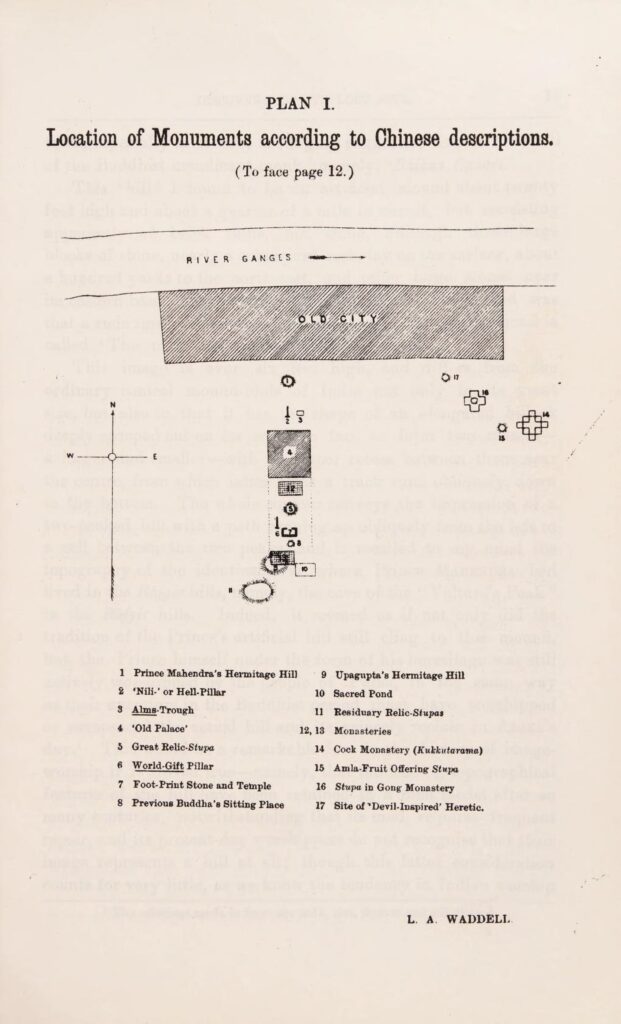‘’Among famous places, busy marts, and emporiums, Patliputra will be the greatest, but three perils will threaten it, fire, water and the internal strife’’ said Lord Buddha in 6th century BC on future prospect of Patliputra.
And, two and half thousand years later, now in 21st century, this is what Prof. Nayanjot Lahiri said ‘’….the core of ancient Patliputra still lies untouched. We only know what is on peripheries. Ancient Patliputra is buried under modern Patna. The high mounds that you see along the Ganga is ancient Patliputra. And because it is buried, we know so little about it….’’ (excerpt 1:11:09 to 1:11:34 from the video ‘’Ashoka: History and Memory | Prof. Nayanjot Lahiri, Ashoka University’’.
How prophetic! Perhaps, the people of the region are too busy with the ”internal strife” to care about Patliputra.
| IMPORTANCE OF PATLIPUTRA |
| According to scripture, Lord Buddha stayed for a night in the village Patli Gram while going from Rajgriha (Rajgir) to Kushinara few months before his parinirvana. |
| Buddha is said to have seen the selection of the place for construction of a fort by the ministers of King Ajatshatru and prophesied ‘’among famous places, busy marts, and emporiums, Patliputra will be the greatest, but three perils will threaten it, fire, water and the internal strife’’. |
| Patliputra is the city where Emperor Ashoka, the greatest ruler in the world history was born in 304 BC to King Bimbisar. He lived much of his life here in Patliputra and ruled over the biggest empire ever in the Indian history from this city as his capital. |
| It is here in Patliputra, Ashoka formulated, implemented and propagated the state ideology of non-violence, respect for diversity, tolerance for various sects, separation of state from personal faith, and welfare of people and the animals thus writing down the core human values in stones in ancient times as the operating principles of governance and founding the first modern welfare state in the world in antiquity. The name of Ashoka shines, in the words of H.G.Wells, and shines, almost alone, a star. |
| Unfortunately, almost all of the significant tangible physical evidences of Patliputra such as Ashoka’s palace, monuments etc still lie deep buried in the mounds of modern Patna awaiting to be discovered and cherished. As Prof. Nayanjot Lahiri said, ‘’….the core of ancient Patliputra still lies untouched. We only know what is on peripheries. Ancient Patliputra is buried under modern Patna. The high mounds that you see along the Ganga is ancient Patliputra. And because it is buried, we know so little about it….’’ (excerpt 1:11:09 to 1:11:34 from the video ‘’Ashoka: History and Memory | Prof. Nayanjot Lahiri, Ashoka University’’. Available at https://www.youtube.com/watch?v=Z1pXJBDs2W0 |
LOCATION OF MONUMENTS ACCORDING TO CHINESE DESCRIPTIONS

GOOGLE MAP:
TIME-LINE OF PATLIPUTRA
During Buddha’s time, Rajgir and Vaishali were two key power centres as the capitals of Magadh under Ajatshatru and Lichhavis. Patliputra was still a village (known as Patligram) between Rajgir and Vaishali on the south side of the river Ganges. The Magadh ruler King Ajatshatru considered this village strategically important hence built a fort and shifted his capital in due course thus transforming the village Patligram to the major centre of trade and imperial power in the world in ancient times.
| [Phase A] ERA OF PATLIPUTRA AS THE GREATEST CITY IN THE WORLD (600 BC–600 AD): The story of Patliputra (Palibothra of Greeks) starts with Lord Buddha’s prophesy. The city actually rose to the prominence to become one of the greatest cities of the world during reigns of Mauryas and Guptas then declined to be lost in absolute oblivion for over thousand years. |
| Year | Person | Event |
| c.543 BC (6th century BC) | Lord Buddha | Lord Buddha stayed for a night in the village Patligram while going from Rajgriha (Rajgir) to Kushinara for months before his Parinirvana where he is said to have prophesied ‘’among famous places, busy marts, and emporiums, Patliputra will be the greatest, but three perils will threaten it, fire, water and the internal strife’’. |
| Ajatshatru | Founded Patliputra but did not shift his capital even after annexing Vaishali (of Lichchavi) | |
| Udayin | Shifted capital of Magadh to Patliputra (from Rajgir) | |
| 372 BC | Mahapadma Nand | Took over the reign of Patliputra |
| reign: 321–297 BC | Chandragupta Maurya | Defeated Greeks took over the reign of Patliputra from Nanda to found the legendary Maurya dynasty of Patliputra |
| Megasthenes | Lived in Patliputra in Chandragupta’s court as Greek ambassador of Seleucus I Nicator; wrote Indika; First European to leave a written account of India | |
| (c. 265–238 BCE; also given as c. 273–232 BCE) | Ashoka the Great | Patliputra became the greatest city of India in terms of prosperity, influence and splendour. Prior to Ashoka, wood was the building material used in Patliputra. Ashoka switched over to stones from wood. His palace was made entirely of stones. Third Buddhist Council was held in 17th year of Ashok’s reign in Patliputra under the presidentship of Moggaliputta (also known as Upagupta). The Third Council established the unity of sangha. During Ashoka’s time, the majestic Kukkuta Sangharama (सँघाराम) was a very influential monastery situated to the south east of the capital city of Patliputra, the citadel of Buddhism in the olden times. |
| 2nd century BC | Patanjali | Patanjali, the author of Mahabhasya flourished in Patliputra |
| 1st century AD | Patliputra fell in the hands of Kushanas and Greeks and the city declined | |
| 320 AD–550 AD | Reign of Gupta Kings; Patliputra rose into prominence again | |
| Early 5th century AD | Fa Hsien (or Fahien) | Chinese pilgrim Fahien visited Patliputra in early 5th century AD under Gupta kings; found Patliputra to be a flourishing city; was spellbound to see the gigantic palace of Ashoka made entirely of stone which was still in good state of preservation. He mentioned of Ashoka’s Royal Palace and the Hall which possibly corresponds to the 80-pillared Hall discovered in Kumhrar |
| 7th century AD (629–645 AD) | Hiuen Tsiang (or Xuan Zang) | After Gupta reign, Patliputra again declined. During Chinese pilgrim Hiuen Tsiang (also called Xuan Zang) visit to Nalanda in 7th century, Kannauj was India’s capital under King Harsha Vardhan. He found Patliputra to be almost wholly destroyed. |
| [Phase B] ERA WHEN PATLIPUTRA WAS IN A STATE OF COMPLETE OBLIVION (7th – 17th CENTURY AD): Fresh settlements appeared in the 17th century BUT the legendary city of Patliputra was lost in absolute oblivion. Despite the written accounts of Patliputra by the Greek ambassador, Chinese pilgrims and other travellers of ancient times, no one knew about the exact location of the site of Patliputra. |
| [Phase C] SEARCH FOR PATLIPUTRA BEGINS IN THE BRITISH PERIOD (18th – 19th CENTURY): Search for Patliputra in the modern period by the British Indian administrators and archaeologists begins |
| Year | Person | Event |
| – | – | Based on Megasthenes’s description in Indica, some thought Patliputra to be in Bhagalpur while others thought it to be near the junction of Kosi and Ganga. |
| 1783 AD | Major Rennell | First indicated precise location of Patliputra near modern Patna. |
| 1872 AD | J.D. Begler | Reported modern Patna stands very close to the site of ancient Patliputra and suggested part of the old city was perhaps washed away by the river Ganges. He noted a small brick mound in a location south-east of Patna which, according to him, clearly was the ruins of Kukkutarama monastery. |
| Alexander Cunningham | After inspection of the site, Cunnigham opined that the remains of Patliputra still existed at Chhoti and Pancha Pahari. His excavation of the mounds did not yield any significant finding. | |
| 1892 | L.A. Waddell | According to description of Megasthenes, Patliputra was defended by broad and deep navigable moats (deep and wide trench around the rampart of a fort that is usually filled with water for protection) on three sides and the fourth or north side by the Ganges. Further, the protected area of Pataliputra was fortified by massive timber palisades of sal. Dr L.A. Waddell (of Indian Medical Service) visited Patna in 1892 and successfully identified the Royal Pataliputra bounded on three sides by deep moats and the fourth or north side by the Ganges. In order to identify monuments of Mauryan times, he carried out excavations at Buladibagh, Chhoti Pahari, Tulsimandi and Maharajkhand to north east of Kumhrar and at Rampur, Bahadurpur, and Pirthipur in the south of Patna. At Buladibagh, Chhoti Pahari, Tulsimandi and Maharajkhand, Waddell discovered remains of wooden beams arranged in double rows (remains of timber palisades). He also found remains of wooden drain in Rampur and Bahadurpur as well as a broken Ashokan Pillar in Kumhrar. In his report, he had observed that ‘’the site of Kukkutarama Monastery may now be occupied by the village of Tulsi Mandi. |
| 1897-1898 | P.C. Mookherjee | Conducted excavation in Lohanipur to find a Buddhist railing, Ashokan pillar capital in flattened vase, traces of wooden palisades and wooden drain. |
| 1912-1913 | D.B.Spooner | Spooner’s excavation at Kumhrar brought to light the presence of Mauryan Pillared-Hall |
| 1926-1927 | J.A. Page & M. Ghosh | Excavation of Bulandibagh threw further light on wooden palisades and the wooden drain |
| 1951-1955 | BP Sinha & A. Narain | Kumhrar was again chosen for archaeological excavation after about four decades of Spooner’s excavation to resolve some issues regarding Mauryan Pillared Hall. |
REFERENCES:
SELECTED VIDEOS
Maurya’s Raj Mahal, Ancient Capital of India, Kumhrar, Patna, Bihar
***
